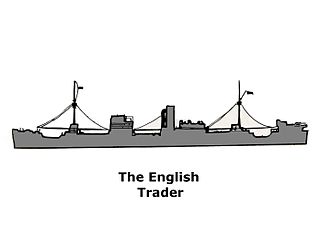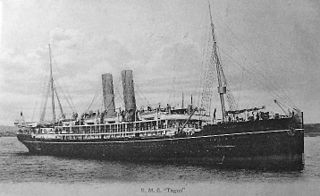
Henry George Blogg GC BEM was a lifeboatman from Cromer on the north coast of Norfolk, England, and the most decorated in Royal National Lifeboat Institution (RNLI) history.

Jun'yō Maru (順陽丸) was a cargo steamship that was built in Scotland in 1913, served a succession of British owners until 1927, and was then in Japanese ownership until a Royal Navy submarine sank her in 1944.

The SS English Trader was a British merchant ship wrecked off the coast of Norfolk, England in October 1941. After falling behind a convoy during the Second World War of which she was a part, the ship ran aground on the Hammond's Knoll sandbank and began to break up during a gale. Several rescue attempts by lifeboats failed, but a further attempt the following day by the Cromer Lifeboat rescued 44 of the crew, three having already been lost.

The SS Mount Ida was a cargo ship built in 1938 by William Hamilton & Co. Ltd of Glasgow. Launched in 1938 as Arcscott, she was renamed Mount Ida after being bought by the Atlanticos Steam Ship Company Ltd, of Athens, Greece. She was wrecked in 1939 after being in service for only about 18 months.

SS Soesterberg was a Dutch-owned cargo steamship that was built in Belgium in 1927 and sunk by a U-boat in 1940 in the Battle of the Atlantic.

SS Cantabria was a Spanish-owned cargo steamship that was built in 1919 in Canada and sunk in 1938 in a naval action in the Spanish Civil War in the North Sea. She was built as War Chief, renamed Alfonso Pérez shortly after she was built, and renamed Cantabria during the Spanish Civil War.

RNLB Henry Blogg was the eighteenth lifeboat to be stationed at Cromer in the county of Norfolk.

Great Yarmouth and Gorleston lifeboat station is a RNLI base in Norfolk, England. There were originally two separate stations at Great Yarmouth and Gorleston – two coastal towns either side of the River Yare. These were merged in 1926.
MV British Prudence was a tanker built by Sir James Laing & Sons Ltd. of Sunderland in 1939 and operated by the British Tanker Company. A U-boat sank her in 1942 off the coast of Newfoundland. She was a victim of the Second Happy Time: the Kriegsmarine's Operation Drumbeat to sink Allied merchant shipping in the Western Atlantic

SS Monte Nevoso was a cargo steamship that was launched in 1920 in England, owned in Italy, and wrecked in 1932 in the North Sea off the coast of Norfolk.
The SB Hibernia was a 75-ton spritsail Thames barge built in Greenhithe, Kent in England in 1906, and which was wrecked on the North Sea coast at East Runton during the night of 9/10 November 1937. Her crew of three were rescued by the Cromer lifeboat.

SS Meriones was a Blue Funnel Line refrigerated cargo steamship. She was launched in 1921 on the River Tyne as one of a class of 11 ships to replace many of Blue Funnel's losses in the First World War.
SS Gallois was one of seven merchant vessels which became stranded and then wrecked on Haisbro Sands of the Norfolk coast on 6 August 1941 during the Second World War. The SS Gallois had been part of a convoy with the designation Convoy FS 559.

Alf was a three-masted Norwegian barque which became stranded and then wrecked on 23 November 1909 on Haisbro Sands, off the coast of Norfolk. She was originally built in 1876 as Inchgreen for Scottish owners. In the 1890s she was sold to Danish owners and renamed Adolph Harboe. Around the turn of the 20th century she was sold to Norwegian owners and renamed Alf, serving until she was wrecked off the coast of Norfolk.

William George Fleming GC (1865–1954) was a lifeboatman from Gorleston-on-Sea on the east coast of Norfolk, England. His service with the Royal National Lifeboat Institution (RNLI) spanned nearly fifty years, in which time he won the George Cross and the RNLI Medal in Gold and in Silver, and the Bronze Medal three times.
SS Hopelyn was a merchant ship from Newcastle that became stranded and then wrecked on Scroby Sands of the Norfolk coast on 17 October 1922.

HM Trawler Agate was purchased by the Royal Navy in 1935. She was modified from a trawler to be used to carry out anti-submarine work. In 1941 she was with the maintenance reserve at Rosyth, but in August was part of the Royal Navy's escort flotilla with convoy FS559 when she ran aground, becoming a total loss, on Haisborough Sands on 6 August with a loss of sixteen crewmen.

SS Trent was a British steamship that was built in 1899 as an ocean liner for the Royal Mail Steam Packet Company (RMSP) service between England and the Caribbean. In the First World War she was a Royal Navy depot ship. She was scrapped in 1922.

USS St. Francis (ID-1557) was a cargo steamship. She was built in Ireland in 1914 as San Francisco, and renamed St. Francis in 1918 when she was commissioned into the United States Navy. In 1933 she was renamed Lammot du Pont. In 1942 she was sunk by a U-boat, and 19 of her crew were lost.

The SS Fernebo was a Swedish cargo ship that was built in 1912. She was wrecked off Cromer, Norfolk, in England on 9 January 1917, being split in two by a boiler explosion or a German sea mine. Her chief engineer was killed but the remaining 17 crew members were rescued by onlookers and the Cromer lifeboat, commanded by Henry Blogg. Part of her wreck remains on the beach at Cromer but is only visible at extremely low tides.

















